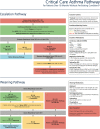Implementation of a Critical Care Asthma Pathway in the PICU
- PMID: 33604577
- PMCID: PMC7886451
- DOI: 10.1097/CCE.0000000000000334
Implementation of a Critical Care Asthma Pathway in the PICU
Abstract
Objectives: Acute asthma management has improved significantly across hospitals in the United States due to implementation of standardized care pathways. Management of severe acute asthma in ICUs is less well studied, and variations in management may delay escalation and/or deescalation of therapies and increase length of stay. In order to standardize the management of severe acute asthma in our PICU, a nurse- and respiratory therapist-driven critical care asthma pathway was designed, implemented, and tested.
Design: Cross-sectional study of severe acute asthma at baseline followed by implementation of a critical care asthma pathway.
Setting: Twenty-six-bed urban quaternary PICU within a children's hospital.
Patients: Patients 24 months to 18 years old admitted to the PICU in status asthmaticus. Patients with severe bacterial infections, chronic lung disease, heart disease, or immune disorders were excluded.
Interventions: Implementation of a nurse- and respiratory therapist-driven respiratory scoring tool and critical care asthma pathway with explicit escalation/deescalation instructions.
Measurements and main results: Primary outcome was PICU length of stay. Secondary outcomes were time to resolution of symptoms and hospital length of stay. Compliance approached 90% for respiratory score documentation and critical care asthma pathway adherence. Severity of illness at admission and clinical baseline characteristics were comparable in both groups. Pre intervention, the median ICU length of stay was 2 days (interquartile range, 1-3 d) with an overall hospital length of stay of 4 days (interquartile range, 3-6 d) (n = 74). After implementation of the critical care asthma pathway, the ICU length of stay was 1 day (interquartile range, 1-2 d) (p = 0.0013; n = 78) with an overall length of stay of 3 days (interquartile range, 2-3.75 d) (p < 0.001). The time to resolution of symptoms was reduced from a median of 66.5 hours in the preintervention group to 21 hours in the postintervention compliant group (p = 0.036).
Conclusions: The use of a structured critical care asthma pathway, driven by an ICU nurse and respiratory therapist, is associated with faster resolution of symptoms, decreased ICU, and overall hospital lengths of stay in children admitted to an ICU for severe acute asthma.
Keywords: critical care; critical pathway; length of stay; noninvasive ventilation; pediatrics; severe acute asthma.
Copyright © 2021 The Authors. Published by Wolters Kluwer Health, Inc. on behalf of the Society of Critical Care Medicine.
Conflict of interest statement
The authors have disclosed that they do not have any potential conflicts of interest.
Figures



References
LinkOut - more resources
Full Text Sources
Other Literature Sources

